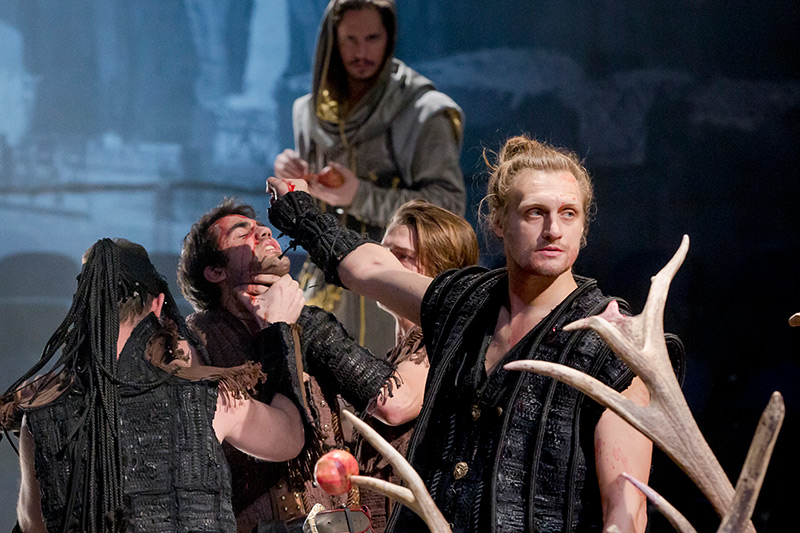Scourge of God at the National
Have you ever wanted to be on the stage of Budapest’s National Theater? Well, with the current production of Isten Ostora (Scourge of God), the nearly 3-hour adaptation of Miklós Bánffy’s original play about Attila the Hun, you finally get the chance.
We are seated onstage, sitting on four sides of the deep acting area with a rotating platform on one end, then a ramp and a torn cyclorama depicting the Colosseum on the other. At the beginning, for the most part, the characters move through the vast, undefined space, delivering the text and making repetitive gestures. (They often stab the floor or drop money. Throwing dust to signify horse riding is a clever touch.) The visual world, designed by Olekszandr Bilozub, is attractive and fascinating, though sometimes too dimly lit. Sonically, the music vacillates between a passage from Mozart’s Requiem and sensual jazz. Thankfully, live vocals are provided by Éva Kanalas as the Shaman Priestess, which relieves the sense of monotony.
The overall effect is less of a theatrical performance and more of a live-action museum exhibit, strongly reminiscent of the Feszty Panorama Arrival of the Hungarians displayed at the National Heritage Park in Ópusztaszer. (And why not? Both works feature a shaman priestess. Also the theme of the painting was suggested by artist’s father-in-law, author Mór Jókai, who worked in the same Wild Romantic style that dominates Miklós Bánfy’s original play.) It seems that director Attila Vidnyánszky wishes to weave a tapestry of movement and sound, and he is more successful on this occasion than in his production of The Passion of Christ from Csíksomlyó. Unfortunately, even from the best seat (on the edge of Sector C), it can be bloody hard to hear and understand. Also, in such a vast space, with many of the laws of time and space suspended, we begin to lose all sense of drama, tension, and plot. It is rather like watching a board game where only one player is pushing all the figures around.
In the first half, two actors stand out for their ability to establish a character – or, at the very least, to decoratively embody their roles. The first is Lajos Ottó Horváth as the Hun general Berik. He has the clearest dramatic arc through the piece. Still, at the outset, he is called upon to lift and move the massive throne (like a feat of strength) so many times that the act eventually becomes meaningless. The second is Tibor Fehér as the Goth soldier Ataulf. He does some impressive sword work – though, again, the effect is it mostly ornamental or symbolic with little relation to the events around him. (Is the character merely practicing his battle moves in the meantime?) After the intermission, Gyula Bodrogi (soon to be 84 years old) appears, and with his inimitable stage presence, he supplies a very watchable court jester.
Most of the other actors are forced to simply shout their lines as best as they can. For example, Estilla Mikecz, who I believe is talented (she was responsible for some memorable moments in Vidnyánszky’s production of Psyche) gives us a very one-note heroine as Mikolt, the Goth princess. There is one gender-bending role, Tibor Mészáros as the princess, but he primarily minces about in that peculiar way that women practically never do. László Mátray is solid as Attila the Hun when he finally appears (after 80 minutes, at about the mid-point of the play). Remarkably, he does not strike us as an actor, but more of a force that everyone else must contend with.
This brings us to the most interesting point of the production. What exactly is the play’s take on Attila the Hun? While some debate that he is not related to the Hungarians at all, for many, this fearless and warlike ancestor is a source of pride. Take the historical novel Lathatatlan Ember [Invisible Man] by Géza Gardonyi or the remarks of poet Attila József, played over the speakers before the performance. Yet, inescapably, he represents an alien from the East, invading Europe and destroying Christianity – an embodiment of all the forces that today’s politicians summon up to inspire fear.
Mikolt, the Goth princess, is Attila’s sworn enemy and prisoner. While struggling to buy her freedom, she urges both Berik and Ataulf to assassinate the conquering Hun. As these plots fail one by one, it becomes increasingly clear that only she will have the opportunity to kill Attila, avenging her slaughtered race by murdering the leader in his bed of conquest.
If you are familiar with the Wild Romantic style, you can see precisely where we are headed. This avenging virgin Judith will eventually find it in her heart to love the bloody oppressor Holofernes. This twist may be incredible. How could she possibly be capable of loving him? Still, Mikolt’s emotions may express the Hungarians’ own conflicted feelings over the historical legacy of Attila the Hun.
A bejegyzés trackback címe:
Kommentek:
A hozzászólások a vonatkozó jogszabályok értelmében felhasználói tartalomnak minősülnek, értük a szolgáltatás technikai üzemeltetője semmilyen felelősséget nem vállal, azokat nem ellenőrzi. Kifogás esetén forduljon a blog szerkesztőjéhez. Részletek a Felhasználási feltételekben és az adatvédelmi tájékoztatóban.





